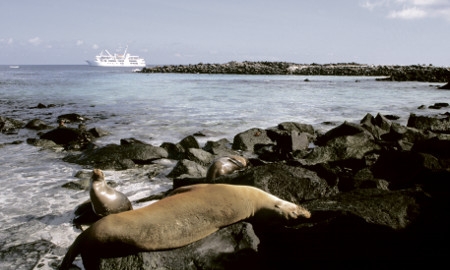Guayaquil is the best point to depart for the Galapagos Islands, which are about 1,000 kilometers from the Ecuadorian mainland. The famous archipelago is one of the best places in the world to study the evolution of the species and was the base for the naturalist Charles Darwin, who was the first to study such matters after arriving there in 1835, fascinated by the islands’ fauna. Although he only stayed on the islands for five weeks, what he found in that time helped him to develop his theory of evolution on his return to England in his book “On the Origin of Species”. The islands were discovered by chance in 1535 during a trip to Peru by Tomás de Berlanga, the Bishop of Panama, when his ship got blown off course. In 1570 they appeared on a map by Abraham Ortelius with the name Insulae de los Galopegos (Islands of the Tortoises).
The official name of the Galapagos Islands is the Colon archipelago, although the administrative name is Galapagos Province. The first crude navigation chart of the islands was made by the buccaneer Ambrose Cowley in 1684. He named the individual islands after some of his fellow pirates or after the British noblemen who helped the pirate’s cause.
In the past there existed 14 species of Galapagos tortoises: three of these became extinct in the 19th century and the last species to disappear happened on June 24, 2012. Ten species of the gigantic Galapagos turtle however still survive and of course the animal gave its name to the islands.
Amongst the most common endemic reptiles on the islands today are both land and marine iguanas. Mammals include sea lions and fur seals, and among the bird population are lava gulls, penguins, 13 species of finches (including the Darwin finch), the cormorant, hawks, herons and the waved albatross; almost all are rare species that are difficult to see in other parts of the planet.
The Galapagos consists of 13 mainly volcanic islands that are home to many rare and fascinating species like iguanas, turtles, albatross and sea lions. Only five of the islands are inhabited with a total population of around of around 25,000 people: San Cristóbal (the oldest at about 5 million years), Santa Cruz, Isabela, Baltra and Floreana. Another six are much smaller and there are another 107 islets that make up a total area of 8000 km2, some have recently experienced volcanic eruptions.
Tourism is the main source of income for the local economy and Santa Cruz is the most populated island. Puerto Ayora is the economic center, with the biggest population and the most important facilities for tourists arriving on the islands, as well as the Charles Darwin Research Station and the information office of the national park.
The main airport is on Baltra island and La Española is one of the oldest at 3 millions years old. Pink flamingos exist on Floreana island, while La Isabela is the youngest and largest with five volcanoes, including Sierra Negra which has the second biggest crater in the world and last erupted in October 2005.
San Cristóbal is the second most populated island and is home to the provincial capital, Puerto Baquerizo, which has around 6,000 inhabitants who share their home with iguanas, birds, crabs and 200kg sea lions in the nearby port and beaches.
Santiago is named after the patron saint of Spain is also known as San Salvador. It is home to sea iguanas, sea lions, fur seals, land and sea turtles, flamingos, dolphins and sharks. Pigs and goats, which were introduced by humans to the islands caused great harm to the endemic species and have been eradicated. Darwin finches and Galapagos hawks are usually seen, as well as a colony of fur seals.
On Plaza Sur, named in honor of a former president of Ecuador, General Leonidas Plaza, there is a reddish carpet on top of the lava formations. Iguanas (land, marine and some hybrids of both species) are abundant, and large numbers of birds can be observed.
Santa Fe hosts a forest of Opuntia cactus, which is worth seeing, as well the high cliffs that shelter numerous gulls.
There are some 7,200 different species identified and censored in the Galapagos Islands. At the beginning of the 20th century there were 112 species of native plants and animals. Today that figure for animals alone is more than 2,200; one of the latest being the pink iguana that along with the sea dogs and the tortoises are the most numerous species, with 11 separate types and around 15,000 examples existing on the islands. The tortoises, marine iguanas, sea lions, penguins and exotic birds live together in this completely natural zoo.
Together they create an amazing fauna for tourists to see and almost touch with their own hands; they are not aggressive animals and almost seem domesticated. The marine iguanas are perhaps the most surprising due to their ferocious looking appearance but they are tranquil sun-loving animals. Sea lions with ears are common on the island and share their space with people bathing along with a species known as fur seals. The penguins are small and swim in deep waters. Among the birds it is worth spotting the blue-footed boobies, the gannets, the albatrosses and the pelicans. Darwin analyzed 14 different endemic species of finches, all similar but with different beaks. His work ended with a study of the mockingbird, which became important in his development of the theory of evolution.
Ecuador did not officially take possession of the islands until 1832. In 1934 the first laws protecting them were published and in 1978 it was declared the first World Heritage site. In recent years the number of visitors have increased rapidly to its current level of around 200,000 people every year, although according to experts the islands should not be subject to more than 70,000.

0 COMMENTS